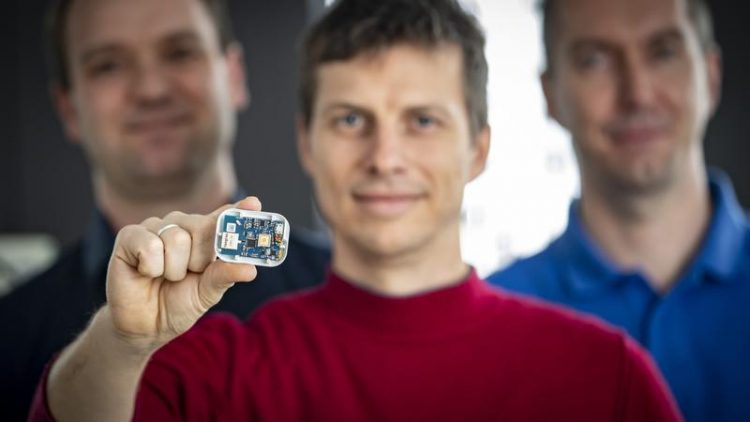Foundations Laid for Building-Scale GPS Technology

They aim to revolutionise mobile navigation within confined spaces. Pictured from left: Daniel Froß, Marko Rößler and Marcel Putsche. Photo: Jacob Müller / Chemnitz University of Technology
Modern mobile navigation is hardly conceivable without the use of satellite-based GPS. Similar solutions that allow for orientation within a small space, for example inside of large, winding buildings, are currently very scarce.
The reason for this: the technological basis for ultra-precise position determination at a micro level is currently missing – until now.
A research team from the Chair of Circuit and System Design at Chemnitz University of Technology has succeeded in developing the first highly efficient localisation chip that combines both the lowest possible energy consumption and very high localisation accuracy.
The joint project “FIND-IT – Competence Platform for Indoor Positioning and Logistics” was funded by the Federal Ministry of Education and Research (BMBF) over a three-year span from 2016 to 2019, to the tune of 1.2 million euros.
In addition to Chemnitz University of Technology, project and application partners on the project include Infineon, the SIMATIC RTLS division from Siemens and SIGMA Chemnitz.
Everything started with the algorithm
Towards the beginning of the development of a functioning prototype, there was the question of a suitable algorithm: “The algorithm helps us determine the exact position of an object in the room,” explains project manager Marko Rößler.
It took around a year of programming by the team to produce the first working version of the algorithm. This was preceded by numerous test-runs in the virtual environment.
After this initial development phase, the team was ready to integrate the algorithm into a microchip. Here, the algorithm itself only functions as an illustration of the functional principle behind the hardware, but this is required for the actual deployment of the technology.
The particular challenge for the team as it transferred software into hardware was that the hardware could not be changed after the fact. “So, we needed to be sure that we didn’t miss anything, in order for the localisation to work later on,” says Rößler.
The advance validation of the location played a special role in this process. For this, the team again completed many test-runs in a virtual setting.
The final step in the development of this new technology was the integration of the finished chip into a prototype. That means the development of mobile hardware that can act as a placeholder for the marketable device.
Following this, the team will be preparing the chip for market readiness as well as full entry into the market.
Dr.-Ing. Marko Rößler from the Professorship of Circuit and System Design, Phone 0371 531-33590, E-Mail marko.roessler@etit.tu-chemnitz.de.
Media Contact
More Information:
http://www.tu-chemnitz.de/All latest news from the category: Information Technology
Here you can find a summary of innovations in the fields of information and data processing and up-to-date developments on IT equipment and hardware.
This area covers topics such as IT services, IT architectures, IT management and telecommunications.
Newest articles

NASA: Mystery of life’s handedness deepens
The mystery of why life uses molecules with specific orientations has deepened with a NASA-funded discovery that RNA — a key molecule thought to have potentially held the instructions for…

What are the effects of historic lithium mining on water quality?
Study reveals low levels of common contaminants but high levels of other elements in waters associated with an abandoned lithium mine. Lithium ore and mining waste from a historic lithium…

Quantum-inspired design boosts efficiency of heat-to-electricity conversion
Rice engineers take unconventional route to improving thermophotovoltaic systems. Researchers at Rice University have found a new way to improve a key element of thermophotovoltaic (TPV) systems, which convert heat…



